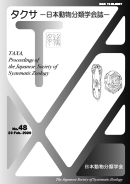Volume 48
Displaying 1-11 of 11 articles from this issue
- |<
- <
- 1
- >
- >|
JSSZ SYMPOSIUM 2019
-
2020 Volume 48 Pages 1-2
Published: February 29, 2020
Released on J-STAGE: March 13, 2020
Download PDF (362K) -
2020 Volume 48 Pages 3-12
Published: February 29, 2020
Released on J-STAGE: March 13, 2020
Download PDF (1614K) -
2020 Volume 48 Pages 13-19
Published: February 29, 2020
Released on J-STAGE: March 13, 2020
Download PDF (1244K) -
2020 Volume 48 Pages 20-26
Published: February 29, 2020
Released on J-STAGE: March 13, 2020
Download PDF (609K) -
2020 Volume 48 Pages 27-33
Published: February 29, 2020
Released on J-STAGE: March 13, 2020
Download PDF (3421K) -
2020 Volume 48 Pages 34-40
Published: February 29, 2020
Released on J-STAGE: March 13, 2020
Download PDF (1029K)
ARTICLES
-
First Japanese records of Saurida undosquamis (Aulopiformes: Synodontidae) from Kagoshima Prefecture2020 Volume 48 Pages 41-48
Published: February 29, 2020
Released on J-STAGE: March 13, 2020
Download PDF (1316K) -
2020 Volume 48 Pages 49-62
Published: February 29, 2020
Released on J-STAGE: March 13, 2020
Download PDF (1863K) -
2020 Volume 48 Pages 63-70
Published: February 29, 2020
Released on J-STAGE: March 13, 2020
Download PDF (1289K) -
Revision of higher taxonomic classification of eukaryote—As for classification in Adl et al. (2019)—2020 Volume 48 Pages 71-83
Published: February 29, 2020
Released on J-STAGE: March 13, 2020
Download PDF (949K) -
2020 Volume 48 Pages 84-91
Published: February 29, 2020
Released on J-STAGE: March 13, 2020
Download PDF (658K)
- |<
- <
- 1
- >
- >|
